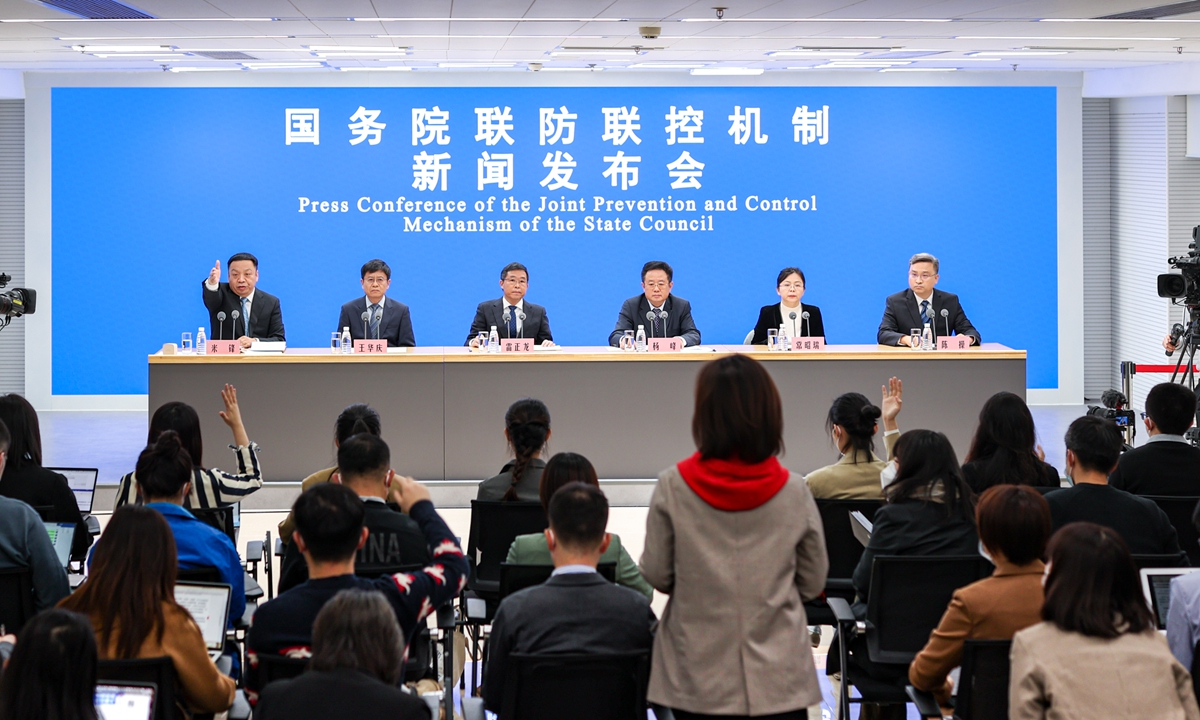
Press Conference of he Joint Prevention and Control Mechanism of the State Council on Sunday Photo: cnsphoto
Sunday marked the first day of China's downgraded management of COVID-19 from Class A to Class B, and the State Council joint prevention and control mechanism against COVID-19 explained the latest edition of China's epidemic response protocol, as a move to further refine management toward reopening, based on science and the epidemic situation.
On Friday, China updated its COVID-19 diagnosis and treatment protocol. There are several major changes in the new program, including renaming "novel coronavirus pneumonia" to "novel coronavirus infection," updating surveillance and alert methods, and adjusting detection strategies, said Lei Zhenglong, an official with the National Administration of Disease Prevention and Control, at a news conference on Sunday afternoon.
The downgrading to Class B is not a case of waiving control, said the National Health Commission (NHC) spokesperson Mi Feng. Rather, the emphasis is on more scientific, precise and efficient control and its integration with economic development. The new version of the protocol advocates increased vaccination and self-protection, calling for enhancing the monitoring of new variants and use of the national influenza surveillance network.
As for the epidemic surveillance system, the Chinese Center for Disease Control and Prevention (CDC) will focus on virus variation surveillance, case reporting, sentinel hospital surveillance, surveillance of pneumonia of unknown cause, and urban sewage surveillance, according to the new protocol. In emergency situations, nucleic acid testing, antigen testing and surveillance of key institutions will be added.
Sewage surveillance will be conducted in cities that are in a position to do so, officials from the National Administration of Disease Prevention and Control said at Sunday's news conference. Both communities and sewage treatment plants will have relevant monitoring sites to aid in assessing the epidemic intensity in cities and communities.
In addition, starting from Sunday, mass nucleic acid screening will no longer be conducted across China. However, communities are being asked to maintain enough nucleic acid testing sites to meet the needs of residents, said Chang Zhaorui, a CDC official, at the news conference. Residents are also being urged to conduct antigen testing on their own if they have symptoms.
Online and bricks-and-mortar pharmacies will provide a sufficient supply of antigen testing reagents, she said.
The CDC is also further improving the surveillance of viral mutations in China, officials said.
The CDC has strengthened sampling and sending for testing and sequencing comparisons for inbound personnel, patients attending clinics, key sites and key populations. It has also strengthened close cooperation with customs on imported virus surveillance.
In terms of domestic surveillance, certain cities and hospitals in each province have been selected as surveillance sites to implement dynamic monitoring of COVID-19 mutations and to detect and report new mutant strains in a timely manner.
So far, no internationally unreported strains have been monitored in the latest wave of the outbreak in China.
"Those adjustments are in line with our overall epidemic prevention and control strategy shift, which means no more stringent management as we have decided to downgrade COVID management and shift the focus from prevention to medical treatment and prevention of severe illness," an expert close to the China CDC who spoke on the condition of anonymity told the Global Times on Saturday.
Statistics show that about 8 percent of the Omicron infections in China in 2022 led to symptoms of pneumonia, which is a relatively low percentage, said Jiao Yahui, an official with the NHC, in an interview with CCTV on Sunday.
Global Times




